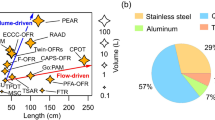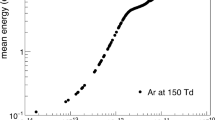Abstract
In this study, we produced a class of diffusion flame soot particles with varying chemical and physical properties by using the mini-Combustion Aerosol STandard (CAST) and applying varying oxidant gas flow rates under constant propane, quenching, and dilution gas supply. We varied the soot properties by using the following fuel-to-air equivalence ratios (Φ): 1.13, 1.09, 1.04, 1.00, 0.96, and 0.89. Within this Φ range, we observed drastic changes in the physical and chemical properties of the soot. Oxidant-rich flames (Φ < 1) were characterized by larger particle size, lower particle number concentration, higher black carbon (BC) concentration, lower brown carbon BrC.[BC]−1 than fuel-rich flames (Φ > 1). To investigate the polycyclic aromatic hydrocarbons (PAH) formation online, we developed a new method for quantification by using the one 13C-containing doubly charged PAH ion in a high-resolution time-of-flight aerosol mass spectrometry (HR-ToF-AMS). The time-resolved concentration showed that the larger PAHs prevailed in the fuel-rich flames and diminished in the oxidant-rich flames. By comparison with the offline in situ derivatization-thermal-desorption gas-chromatography time-of-flight mass spectrometry (IDTD-GC-ToF-MS), we found that the concentration by using the HR-ToF-AMS was underestimated, especially for lower mass PAHs (C14–C18) in the fuel-rich flames possibly due to size limitation and degradation of semi-volatile species under high vacuum and desorption temperature in the latter. For oxidant-rich flames, the large PAHs (C20 and C22) were detected in the HR-ToF-AMS while it was not possible in IDTD-GC-ToF-MS due to matrix effect. The PAH formation was discussed based on the combination of our results and with respect to Φ settings.









Similar content being viewed by others
References
Janssen NA, Hoek G, Simic-Lawson M, Fischer P, van Bree L, ten Brink H, Keuken M, Atkinson RW, Anderson HR, Brunekreef B, Cassee FR (2011) Black carbon as an additional indicator of the adverse health effects of airborne particles compared with PM10 and PM2.5. Environ Health Perspect 119(12):1691–1699
Andreae O, Ramanathan V (2013) Climate dark forcings. Science 340(6130):280–281
Bond TC, Bhardwaj E, Dong R, Jogani R, Jung S, Roden C, Streets DG, Trautmann NM (2007) Historical emissions of black and organic carbon aerosol from energy-related combustion, 1850–2000. Glob Biogeochem Cycles 21(2):GB2018
Petzold A, Ogren JA, Fiebig M, Laj P, Li SM, Baltensperger U, Holzer-Popp T, Kinne S, Pappalardo G, Sugimoto N, Wehrli C, Wiedensohler A, Zhang XY (2013) Recommendations for reporting “black carbon” measurements. Atmos Chem Phys 13(16):8365–8379
Müller K, Spindler G, van Pinxteren D, Gnauk T, Iinuma Y, Brüggemann E, Herrmann H (2014) Ultrafine and fine particles in the atmosphere—sampling, chemical characterization and sources. Chem Ing Tech 84(7):1130–1136
Tumolva L, Park JY, Kim JS, Miller AL, Chow JC, Watson JG, Park K (2010) Morphological and elemental classification of freshly emitted soot particles and atmospheric ultrafine particles using the TEM/EDS. Aerosol Sci Technol 44(3):202–215
Stoeger T, Reinhard C, Takenaka S, Schroeppel A, Karg E, Ritter B, Heyder J, Schulz H (2006) Instillation of six different ultrafine carbon particles indicates a surface area threshold dose for acute lung inflammation in mice. Environ Health Perspect 114(3):328–333
Oberdorster G, Sharp Z, Atudorei V, Elder A, Gelein R, Kreyling W, Cox C (2004) Translocation of inhaled ultrafine particles to the brain. Inhal Toxicol 16(6–7):437–445
Mauderly JL, Chow JC (2008) Health effects of organic aerosols. Inhal Toxicol 20:257–288
Patel MM, Chillrud SN, Deepti KC, Ross JM, Kinney PL (2013) Traffic-related air pollutants and exhaled markers of airway inflammation and oxidative stress in New York City adolescents. Environ Res 121:71–78
Pope CA, Dockery DW (2006) Health effects of fine particulate air pollution: lines that connect. J Air Waste Manag Assoc 56(6):709–742
Schroeppel A, Lintelmann J, Karg E, Ferron G (2003) A.:physical and chemical characterisation of particles produced by a flame soot aerosol generator (CAST). J Aerosol Sci 34:S1253–S1254
Moore RH, Ziemba LD, Dutcher D, Beyersdorf AJ, Chan K, Crumeyrolle S, Raymond TM, Thornhill KL, Winstead EL, Anderson BE (2014) Mapping the operation of the miniature combustion aerosol standard (Mini-CAST) soot generator. Aerosol Sci Technol 48(5):467–479
Maricq MM (2014) Examining the relationship between black carbon and soot in flames and engine exhaust. Aerosol Sci Technol 48(6):620–629
Crawford I, Möhler O, Schnaiter M, Saathoff H, Liu D, McMeeking G, Linke C, Flynn M, Bower KN, Connolly PJ, Gallagher MW, Coe H (2011) Studies of propane flame soot acting as heterogeneous ice nuclei in conjunction with single particle soot photometer measurements. Atmos Chem Phys 11(18):9549–9561
Paur HR, Baumann W, Matzing H, Seifert H (2005) Formation of nanoparticles in flames; measurement by particle mass spectrometry and numerical simulation. Nanotechnology 16:S354–S361
Frenklach M (2002) Reaction mechanism of soot formation in flames. Phys Chem Chem Phys 4(11):2028–2037
Kittelson DB (1998) Engines and nanoparticles: a review. J Aerosol Sci 29:575–588
Slowik JG, Stainken K, Davidovits P, Williams LR, Jayne JT, Kolb CE, Worsnop DR, Rudich Y, DeCarlo PF, Jimenez JL (2004) Particle morphology and density characterization by combined mobility and aerodynamic diameter measurements. Part 2: application to combustion-generated soot aerosols as a function of fuel equivalence ratio. Aerosol Sci Technol 38(12):1206–1222
Santamaria A, Yang N, Eddings E, Mondragon F (2010) Chemical and morphological characterization of soot and soot precursors generated in an inverse diffusion flame with aromatic and aliphatic fuels. Combust Flame 157(1):33–42
Cain JP, Gassman PL, Wang H, Laskin A (2010) Micro-FTIR study of soot chemical composition-evidence of aliphatic hydrocarbons on nascent soot surfaces. Phys Chem Chem Phys 12(20):5206–5218
Oster M, Elsasser M, Schnelle-Kreis J, Zimmermann R (2011) First field application of a thermal desorption resonance-enhanced multiphoton-ionisation single particle time-of-flight mass spectrometer for the on-line detection of particle-bound polycyclic aromatic hydrocarbons. Anal Bioanal Chem 401:3173–3182
Dzepina K, Arey J, Marr LC, Worsnop DR, Salcedo D, Zhang Q, Onasch TB, Molina LT, Molina MJ, Jimenez JL (2007) Detection of particle-phase polycyclic aromatic hydrocarbons in Mexico City using an aerosol mass spectrometer. Int J Mass Spectrom 263(2–3):152–170
Eriksson AC, Nordin EZ, Nyström R, Pettersson E, Swietlicki E, Bergvall C, Westerholm R, Boman C, Pagels JH (2014) Particulate PAH emissions from residential biomass combustion: time-resolved analysis with aerosol mass spectrometry. Environ Sci Technol 48(12):7143–7150
Drinovec L, Močnik G, Zotter P, Prévôt ASH, Ruckstuhl C, Coz E, Rupakheti M, Sciare J, Müller T, Wiedensohler A, Hansen ADA (2014) The “dual-spot” aethalometer: an improved measurement of aerosol black carbon with real-time loading compensation. Atmos Meas Tech Discuss 7:10179–10220
Kirchstetter TW, Novakov T, Hobbs PV (2004) Evidence that the spectral dependence of light absorption by aerosols is affected by organic carbon. J Geophys Res 109, D21208
DeCarlo PF, Kimmel JR, Trimborn A, Jayne JT, Aiken AC, Gonin M, Fuhrer K, Horvath T, Docherty K, Worsnop DR, Jimenez JL (2006) A field-deployable high-resolution time-of-flight aerosol mass spectrometer. Anal Chem 78(24):8281–8289
Pika (ToF_AMS High Resolution Analysis Software); Donna Sueper from Aerodyne Research Inc.: Billerica, MA; available online at http://cires.colorado.edu/jimenez-group/wiki/index.php/ToFAMS_Analysis_Software#Pika_.28ToF_AMS_High_Resolution_Analysis_software.29 (accessed February 2011)
Jimenez JL, Jayne JT, Shi Q, Kolb CE, Worsnop DR, Yourshaw I, Seinfeld JH, Flagan RC, Zhang X, Smith KA, Morris JW, Davidovits P (2003) Ambient aerosol sampling using the Aerodyne Aerosol Mass Spectrometer. J Geophys Res Atmos 108:8425
Berglund M, Wieser ME (2011) Isotopic compositions of the elements 2009 (IUPAC Technical Report). Pure Appl Chem 83:397–410
Orasche J, Schnelle-Kreis J, Abbaszade G, Zimmermann R (2011) Technical note: in-situ derivatization thermal desorption GC-TOFMS for direct analysis of particle-bound non-polar and polar organic species. Atmos Chem Phys 11(17):8977–8993
DeCarlo PF, Slowik JG, Worsnop DR, Davidovits P, Jimenez JL (2004) Particle morphology and density characterization by combined mobility and aerodynamic diameter measurements. Part 1: theory. Aerosol Sci Technol 38(12):1185–1205
Mamakos A, Khalek I, Giannelli R, Spears M (2013) Characterization of combustion aerosol produced by a Mini-CAST and treated in a catalytic stripper. Aerosol Sci Technol 47(8):927–936
Olfert JS, Symonds JPR, Collings N (2007) The effective density and fractal dimension of particles emitted from a light-duty diesel vehicle with a diesel oxidation catalyst. J Aerosol Sci 38(1):69–82
Canagaratna MR, Jayne JT, Jimenez JL, Allan JD, Alfarra MR, Zhang Q, Onasch TB, Drewnick F, Coe H, Middlebrook A, Delia A, Williams LR, Trimborn AM, Northway MJ, DeCarlo PF, Kolb CE, Davidovits P, Worsnop DR (2007) Chemical and microphysical characterization of ambient aerosols with the aerodyne aerosol mass spectrometer. Mass Spectrom Rev 26:185–222
Acknowledgments
This work was supported by the Initiative and Networking Fund of the Helmholtz Association. We also acknowledge Ms. Kerstin Koch for the technical assistance.
Author information
Authors and Affiliations
Corresponding author
Additional information
Published in the topical collection Aerosols and Health with guest editor Ralf Zimmermann.
Electronic supplementary material
Below is the link to the electronic supplementary material.
ESM 1
(PDF 865 kb)
Rights and permissions
About this article
Cite this article
Mueller, L., Jakobi, G., Orasche, J. et al. Online determination of polycyclic aromatic hydrocarbon formation from a flame soot generator. Anal Bioanal Chem 407, 5911–5922 (2015). https://doi.org/10.1007/s00216-015-8549-x
Received:
Revised:
Accepted:
Published:
Issue Date:
DOI: https://doi.org/10.1007/s00216-015-8549-x




